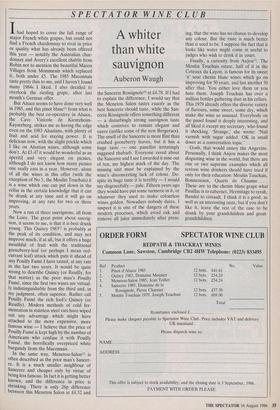SPECTATOR WINE CLUB
A whiter than white sauvignon
Auberon Waugh
Ihad hoped to cover the full range of major French white grapes, but could not find a French chardonnay to rival in price or quality what has already been offered this year — notably the Australian char- donnay and Avery's excellent chablis from Robin not to mention the beautiful Macon Villages from Mommesin which replaced it, both under £5. The 1985 Maconnais taste pretty thin to me, and I haven't found many 1984s I liked. I also decided to overlook the riesling grape, after last month's German offer.
But Alsace seems to have done very well in 1985, and this pinot blanc(1) from what is probably the best co-operative in Alsace, the Cave Vinicole de Kientzheim- Kayserberg, strikes me as having the edge even on the 1983 Alsatians, with plenty of fruit and acid for staying power. It is delicious now, with the slight prickle which I like on Alsatian wines, although some don't. At £3.47 it would be wonderful as an aperitif and very elegant on picnics, although I do not know how many picnics one really eats in a year. However, alone of all the wines in this offer (with the exception of No 5, the Moulin Touchais) it is a wine which one can put down in the cellar in the certain knowledge that it can be drunk at any time and it will go on improving, at any rate for two or three years.
Now a run of three sauvignons, all from the Loire. The great point about sauvig- non, it seems to me, is that it is best drunk young. This Quincy 1983(2) is probably at the peak of its condition, and may not improve much, if at all, but it offers a huge mouthful of fruit with the traditional gooseberry-leaf (or perhaps I mean red- currant leaf) attack which puts it ahead of any Pouilly Fume I have tasted, at any rate in the last two years. It would be quite wrong to describe Quincy (or Reuilly, for that matter) as the poor man's Pouilly Fume, since the first two wines are virtual- ly indistinguishable from the third and, in my judgment, often superior. Rather call Pouilly Fume the rich fool's Quincy (or Reuilly). Modern methods of cold fer- mentation in stainless steel vats have wiped out any advantage which might have attached to the more expensive, more famous wine — I believe that the price of Pouilly Fume is kept high by the number of Americans who confuse it with Pouilly Fuisse, the horrifically overpriced white burgundy from the Maconnais.
In the same way, Menetou-Salonm is often described as the poor man's Sancer- re. It is a much smaller neighbour of Sancerre and cheaper only by virtue of being less famous. In fact it is getting better known, and the difference in price is shrinking. There is only 26p difference between this Menetou Salon at £4.52 and the Sancerre Rossignole at £4.78. If I had to explain the difference, I would say that the Menetou Salon tastes exactly as the best Sancerre should taste, while the San- cerre Rossignole offers something different — a disturbingly strong sauvignon taste which contrives to remain elegant and suave (unlike some of the new Bergeracs). The smell of the Sancerre is more flint than crushed gooseberry leaves, but it has a huge taste — one panellist irritatingly suggesed rhubarb. Everyone raved about the Sancerre and I see I awarded it nine out of ten, my highest mark of the day. The missing unit must be explained by the wine's disconcerting lack of colour. De- spite its huge taste it is terribly — I would say disgracefully — pale. Fifteen years ago they would have put some turmeric in it, or whatever they used to make colourless wines golden. Nowadays nobody dares. I suspect it is one of the dangers of these modern processes, which avoid oak and remove all juice immediately after press- ing, that the wine has no chance to develop any colour. But the taste is much better than it used to be. I suppose the fact that it looks like water might come in useful to judges who wish to drink it in court.
Finally, a curiosity from Anjou('). The Moulin Touchais estate, half of it in the Coteaux du Layon, is famous for its sweet 'n' sour chenin blanc wines which go on improving for 50 years, and last another 50 after that. You either love them or you hate them. Joseph Touchais has over a million bottles gathering dust in his cellars. This 1979 already offers the diverse variety of flavours, some sweet, some dry, which make the wine so unusual. Everybody on the panel found it deeply interesting, and all liked it except my secretary, who found it shocking. 'Strange,' she wrote: 'Nail varnish with sugar added. OK in small doses as a conversation topic.'
Gosh, that would annoy the Angevins. Personally, I think Anjou makes the most disgusting wine in the world, but there are one or two supreme examples which all serious wine drinkers should have tried if only for their education: Moulin Touchais, Bonnezeaux, Quarts de Chaume. . . . These are to the chenin blanc grape what Pauillac is to cabernet, Hermitage to syrah, Bandol to cinsault. I think it is a good, as well as an interesting taste, but if you don't like it, leave the rest of the case to be drunk by your grandchildren and great- grandchildren.










































 Previous page
Previous page